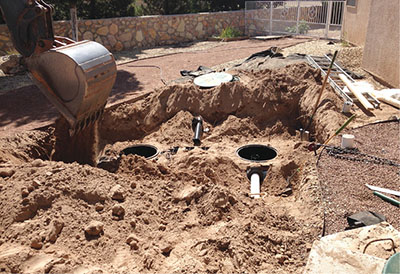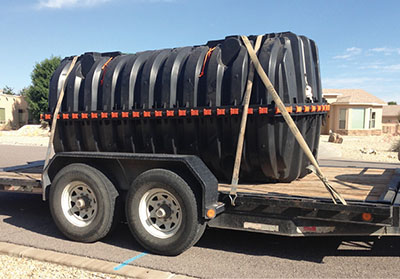Guide M-113
Revised by Stephanie J. Walker
College of Agricultural, Consumer and Environmental Sciences, New Mexico State University
Author: Extension Vegetable Specialist/Assistant Professor, Department of Extension Plant Sciences, New Mexico State University. (Print friendly PDF)
Introduction
A septic tank is an underground sewage collection system (Figure 1). The tank itself is a watertight container constructed of a sound, durable material resistant to corrosion and decay. The most common type is concrete septic tanks. These should be constructed of a high-quality concrete to reduce the risk of premature cracking or deterioration of the septic tank. The internal walls of concrete septic tanks are coated with a durable, waterproof material, such as coal tar epoxy, to prolong the integrity of the tank.
Another option is a poly septic tank, which is made of polyethylene plastic (Figure 2). While somewhat more expensive to purchase, poly septic tanks are easy to install. They also are corrosion-proof and less likely to be damaged by tree roots compared to concrete septic tanks.
In recent years, premature deterioration of concrete septic tanks has been increasingly reported. While the underlying causes continue to be investigated, evidence points to formation of gases inside the tank that degrade the concrete. These corrosive gases have been possibly attributed to fermentation of food waste from garbage disposals; modern cleaning chemicals, especially products used to remove hard water lime deposits; and flushing certain medications into the system. Installing a “whirlybird” device, to vent corrosive gases from the septic tank, may alleviate the problem. If corrosion is a concern, installing a poly septic tank may be preferable.
Another critical decision when installing a septic tank is the appropriate size. Your selection should be determined by the number of bedrooms or fixture units (toilets, sinks, showers/tubs, etc.) to be served. New Mexico Plumbing Code requires minimum septic tank sizes (Table 1).

Figure 1. A septic tank being buried in a yard.

Figure 2. A poly septic tank.
|
Table 1. New Mexico Plumbing Code Required Septic Tank Sizes |
|
|
Single-family dwelling size |
Minimum septic tank size (gallons) |
|
0–2 bedrooms |
750 |
|
3 bedrooms |
1,000 |
|
4 bedrooms |
1,200 |
|
5–6 bedrooms |
1,500 |
How Does a Septic Tank Work?
As the septic system is used, solids—sometimes referred to as sludge—accumulate in the tank. The septic tank removes solids by holding wastewater in the tank for at least 24 hours, allowing the solids to settle and scum to rise to the top. This is accomplished by a series of baffles inside the tank. Up to 50% of the solids retained in the tank will decompose over time. Treated effluent water discharges from the tank to perforated drainpipes. The pipes are buried in a constructed absorption or “leach” field. The effluent leaves the buried drainpipes and percolates through the subsoil and eventually to groundwater.
Septic Tank Maintenance
As you use your septic system, sludge will accumulate in the tank. Properly designed tanks have enough space for up to three years of safe accumulation. Once the sludge has reached this level, the separation of solids and scum no longer takes place, and sewage may overflow into the absorption area. This can be prevented by periodically pumping the accumulated sludge.
How Often Should You Pump?
Pumping frequency depends on the following:
-
Capacity of septic tank
-
Volume of wastewater flow
-
Volume of solids in wastewater
Volume of wastewater flow is determined by the type and frequency of common household activities, such as flushing toilets, bathing, and washing dishes. Water conservation practices in the home will help to limit the flow into the system. Using an in-sink garbage disposal will increase the volume of solids. Care should be given to the type and amount of solids disposed of through a garbage disposal. Continuous running water, from a toilet or leaky faucet, or draining of a whirlpool tub may stir up the solids in the septic tank, contributing to leakage of sludge into, and possible failure of, the absorption field.
Table 2 gives the pumping frequencies according to the size of the septic tank. Please note that biological and chemical septic tank additives are not necessary and do not eliminate the need for pumping.
|
Table 2. Estimated Septic Tank Pumping Frequencies (in years) for Year-round occupancy |
|||||
|
Tank size (gallons) |
Household size (number of people) |
||||
|
1 |
2 |
3 |
4 |
5 |
|
|
750 |
9 |
4 |
3 |
2 |
1 |
|
1,000 |
12 |
6 |
4 |
3 |
2 |
|
1,250 |
16 |
8 |
5 |
3 |
3 |
|
1,500 |
19 |
9 |
6 |
4 |
3 |
|
1,750 |
22 |
11 |
7 |
5 |
4 |
|
Note: More frequent pumping needed if garbage disposal is used. |
|||||
Safe Use of Septic Systems
Do not put substances such as motor oil, gasoline, paints, thinners, and pesticides in drains. These materials may pollute the groundwater and are toxic to the microorganisms that maintain an active septic system.
Moderate use of household cleaners, disinfectants, detergents, or bleaches will do little harm to the system, but remember that where there is a high density of septic systems there may be a cumulative impact on groundwater from household cleaners.
The use of continuous toilet deodorizers, which are set in the toilet bowl, can kill beneficial microorganisms that are critical to breaking down waste in the septic tank. Flushing large amounts of antibiotic medications or antibacterial cleaning products can also adversely affect beneficial microbes.
Fats, grease, coffee grounds, paper towels, sanitary napkins, disposable diapers, cigarettes, flushable cat litter, and other such items will clog your septic system.
Protect the Absorption Field
The absorption field must be protected so the soil does not become compacted, which can prevent the drainpipes from functioning. Keep automobiles and heavy equipment off the absorption field. Grass cover and shallow-rooted plants are beneficial over the absorption field, but the deep roots of trees and shrubs stress and may plug nearby drain lines. Flood irrigation above the absorption field may also result in plugged drain lines. Do not fertilize the soil above the drain field.
Grass on the surface of an absorption field should be mowed regularly to promote evaporation and removal of water through the leaves. This helps prevent water from unnecessarily infiltrating the soil above the absorption field.
Conserve Water
Remember to consider the capacity of your septic system when installing new appliances or plumbing. Limit the water entering the tank. Use water-saving fixtures. Repair toilet float valves, leaks, and dripping faucets.
Avoid Septic Tank Additives
Yeasts, bacteria, enzymes, and chemicals are sold that claim to help septic systems work better; however, there is no scientific evidence that additives are effective. In fact, some cleaners allow the solids in an overloaded tank to be re-suspended and clog the drainage lines.
Additives are not an alternative to proper maintenance and do not eliminate the need for routine pumping of a septic tank.
Commercial biological additives are not necessary for restarting decomposition after pumping because the sludge residue contains active microorganisms.
How to Recognize Problems
Learn how to recognize problems with septic systems. For example, unusually lush and green grass over your drain field may indicate trouble. Also, pay attention to slow-draining toilets or drains, sewage odors, or sewage backing up into the house or over the drain field.
Checklist for Good Septic Tank Maintenance
-
Check your system annually for leaks and sludge.
-
Have your septic tank pumped by a licensed pumping contractor.
-
Practice water conservation. Repair leaky faucets and toilets. Spread clothes washing over the entire week, and operate washing machines only with a full load of laundry.
-
Learn the location of your septic system’s components. Make a map and keep it handy.
-
Keep a maintenance record
| Original author: R. Craig Runyan, Extension Water Quality Specialist. |
For Further Reading
CR-677: Stream Biomonitoring Using Benthic Macroinvertebrates
https://pubs.nmsu.edu/_circulars/CR667/
M-106: Safe Use of Household Graywater
https://pubs.nmsu.edu/_m/M106/
H-707: Landscape Water Conservation
https://pubs.nmsu.edu/_h/H707/
All Agricultural Mechanics & Engineering Publications
https://pubs.nmsu.edu/_m/

Stephanie Walker is Extension Vegetable Specialist, and has extensive experience in the food processing industry. Her primary research interests include genetics and breeding of chile peppers, vegetable mechanization, enhancing pigment content, post-harvest quality, and irrigation efficiency. She works to help commercial vegetable growers enhance the sustainability and profitability of their operations through collaboration, experimentation, and information sharing.
To find more resources for your business, home, or family, visit the College of Agricultural, Consumer and Environmental Sciences on the World Wide Web at pubs.nmsu.edu
Contents of publications may be freely reproduced for educational purposes. All other rights reserved. For permission to use publications for other purposes, contact pubs@nmsu.edu or the authors listed on the publication.
New Mexico State University is an equal opportunity/affirmative action employer and educator. NMSU and the U.S. Department of Agriculture cooperating.
Revised May 2016


